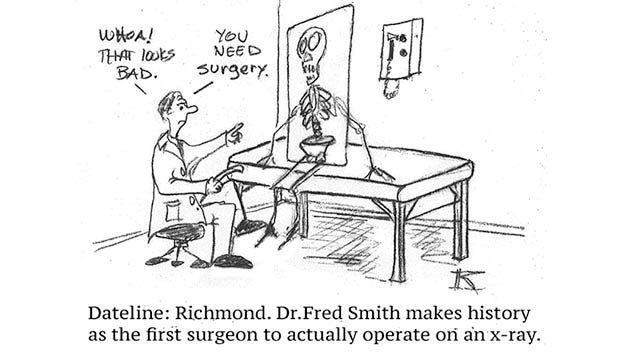Diagnostic dilemma
Published 10:38 am Sunday, February 11, 2024
|
Getting your Trinity Audio player ready...
|
 A gentleman had suffered for years with right leg pain. An MRI of his lumbar spine demonstrated spinal stenosis, a narrowing of the spinal canal. He was referred to a neurosurgeon.
A gentleman had suffered for years with right leg pain. An MRI of his lumbar spine demonstrated spinal stenosis, a narrowing of the spinal canal. He was referred to a neurosurgeon.
“You have a pinched nerve,” the neurosurgeon advised. The spinal canal was narrowed, compressing a nerve. Since the nerve gave sensation to his leg, its irritation caused leg pain. The doctor recommended surgery to decompress the nerve. The gentleman agreed.
After the surgery, there was no improvement in his pain. The neurosurgeon recommended a second operation. He proposed a re-exploration of the decompressed segment combined with a fusion. Again, the gentleman agreed and, again, the surgery failed to relieve his pain.
His family doctor referred him to an orthopedic surgeon for another opinion.
The orthopedist noted there was almost no motion in the patient’s hip. When the doctor attempted to move it, the patient said it caused the pain he had been experiencing for so long. An x-ray of the hip revealed the joint destroyed, probably by avascular necrosis, a disease that results from a loss of blood supply to the bone which can cause the hip to collapse. The doctor recommended a hip replacement operation. The hip replacement finally relieved his leg pain.
He complained of back pain.
DR. WITHERSPOON SAYS:
Ouch! I’m gettin’ back pain just reading about this one, folks.
The kindest that can be said about this case is occasionally, it can be difficult to distinguish between the back and the hip as the cause of thigh pain. It can be a diagnostic dilemma. Referred pain from the back can cause the hip to hurt, mimicking arthritis.
Which is the culprit, the hip or the back? Occasionally, finding the true cause of pain can be difficult.
It would have been easy in this case, however. This patient had a one hundred percent, undiluted, dyed-in-the-wool, thoroughly destroyed hip. Period. It was obvious on the clinical exam, confirmed by x-ray. A third-year medical student worth half his salt would have picked it up.
Had the neurosurgeon performed the most rudimentary of physical examinations, he would have found it, too. Shoot, had he accidentally bumped against the fellow’s knee, it would have made him holler. Or watch him walk; he was hobbling.
He reviewed the lumbar spine MRI, assumed the problem was there, and marched off to surgery. The result was two unnecessary spine operations.
LESSONS LEARNED?
First of all, it can be difficult to pinpoint the source of pain in both the hip and shoulder. Hip arthritis and lumbar spinal stenosis can have nearly identical pain patterns. The same goes for the painful shoulder and upper arm. It could be from a bad shoulder, such as a rotator cuff tear, or it could be from pinched nerves in the cervical spine. Both can be diagnostic dilemmas, perennial sources of consternation to orthopods and neurosurgeons alike. X-rays and the almighty MRI don’t necessarily tell the whole story, you must put it all together and that means you need a good physical examination to match what you see on the studies.
There’s an old saying in medicine; you don’t operate on x-rays, you operate on people. I had a fellow request a second opinion for his knee. An orthopedist told him he had to have a knee replacement and he was leery about it. His x-ray showed one of the worst arthritic knees I’d ever seen.
But the gentleman walked five miles a day and had no pain. He was worried knee replacement surgery might affect that and I unhesitatingly told him that was an excellent concern. The purpose of surgery is to make people better and this fellow was at a hundred percent! How in the world are you going to make that better? I didn’t care what his x-ray looked like, the last thing he needed was somebody switching out a knee that was serving him so well. He was doing great! I told him to leave it be, come back when it hurts.
Likewise, just because there’s an abnormal appearance to the MRI of a lumbar spine, that doesn’t necessarily mean the pain is coming from the back. A lot of folks are walking around with a tight spinal canal and feel just fine. It’s just one piece of the puzzle, the second essential piece being a good physical examination, which I’m beginning to believe is becoming a lost art.
Nowadays, you can click off a completely negative physical examination with the push of a button. I know an orthopedist who twice was consulted on patients admitted for presumed medical problems who had broken hips that were somehow missed upon admission. (How do you get into and out of an ED with a broken hip and nobody knowing about it?) Both patients had been in the hospital for a couple of days before somebody got the bright idea to x-ray the hips that were agonizingly painful with the slightest movement. In both cases, the canned physical examination in the computer-generated H&P described both hips as normal, each with a painless range of motion.
Bilgewater! Obviously, the hips were never examined, the canned physical conveniently clicked as normal in a second. Before the computer took over everything, the common notation for a negative finding was “WNL” which stood for “within normal limits.” Whenever they missed something, the residents sarcastically said it really meant “we never looked.”
Once again, it was just a plain, ol’ ignoring of the basics that did a patient in, and I’m getting mighty tired of it. I’m beginning to believe nobody’s examining patients these days. If there had been a good medical student in his office to do the H&P, it probably would have spared this poor fellow two unnecessary back operations because a ridiculously simple physical examination would have nailed the diagnosis.
An inadequate preoperative evaluation, specifically an inadequate physical examination, combined with a rush to judgment were the culprits in this one.
Doctors – please – go back to your good training, the fundamentals, the basics. They will serve you well. If nothing else, before you document a physical examination in the chart, examine the patient!
That just might be the stupidest advice I’ve ever given, but it needed to be said.
J. M. MacDavid M.D. also known locally as Dr. John Kona can be contacted at WitherspoonInstitute23@gmail.com.






